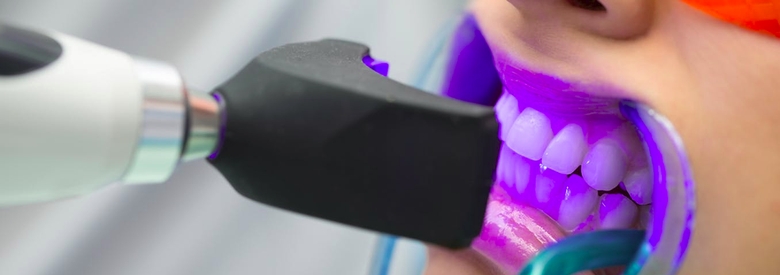
Izbeljivanje zuba je jedna od najčešćih stomatoloških intervencija u aktuelnoj praksi, za koju pacijneti pokazuju sve veće interesovanje. Razlog beljenja zuba uglavnom je estetske prirode. Mogu se beliti i sasvim zdravi ili uglavnom zdravi prirodni zubi, a često se beljenje traži i radi usklađivanja boje prirodnih zuba sa novim krunicama ili fasetama.
Relativno česta je i pojava koju nazivamo tetraciklinski zubi, odnosno zubi posiveli usled uzimanja antibiotika u toku trudnoće. Mrtvi zubi, tj. zubi kod kojih je izvađen živac, vremenom takođe tamne, te pacijneti ponekad zbog njih dolaze na pojedinačno beljenje ili ih promena boje mrtvih zuba motiviše na kompletno beljenje.
Sam proces beljenja zuba sastoji se od nanošenja specijalnih gelova na površinu zuba. Ovi gelovi prolaze kroz gleđ zuba i izbeljuju sam dentin, čime se menja i boja zuba, budući da je gleđ providna i dentin je u potpunosti odgovoran za boju naših zuba. Ovaj gel je na bazi vodonik peroksida ili karbamid peroksida i može se davati u različitim koncentracijama. Gel se može aplikovati u ordinaciji, a može se i aktivirati laserom radi ubrazavanja procedure. U praksi se najbolji rezultat postiže kada se ordinacijskom beljenju dodaju i kućne noćne folije. Međutim, ono o čemu gotovo nijedan pacijent nije unapred informisan jeste da su sve procedure beljenja zuba bolne i neprijatne.
Mnoge ordinacije reklamiraju lasersko izbeljivanje zuba, međutim laser je samo jedan od učesnika u procesu beljenja zuba, i zube definitivno ne beli laser, tako da u našoj praksi koristimo izraz „ordinacijsko beljenje zuba“. Kao što smo naveli, laser samo aktivira peroksid gel, a za aktivaciju može služiti i LED ili halogeno svetlo, tako da je lasersko izbeljivanje zuba zaista samo marketinški izraz, koji ne opisuje verno proces beljenja zuba.
Da bi pacijent podneo ordinacijsko izbeljivanje zuba potrebno je je ponekad dati anesteziju. Nakon samog procesa izbeljivanja povećana je osetljivost zuba i to može da traje nekad i danima nakon intervencije. Ponekad je potrebno da se ponovi beljenje, a poseban problem je rad sa tetraciklinskim zubima, jer je njih veoma teško dovesti do željene boje. Beljenje mrtvog zuba je takođe problematično. Uglavnom je potrebno više seansi, neretko se dešava da se boja zuba vrati već nakon šest meseci, što mogu uzrokovati obojena pića, hrana i cigrarete.
Mnogi pacijenti prolaze kroz tretman bez problema. Pacijenti koji su zadovoljni efektom izbeljivanja kako kućnog tako i ordinacijskog se vraćaju periodično kako bi se postupak ponovio. Činjenica je da beljenje zuba daje vrlo dobar kratkoročan rezultat, te da uz upotrebu kućnih folija moguće dugo zadržati taj efekat. Ipak, ni kućne folije nisu najprijatnije. Nekada postoji malo veća osetljivost, ali to je individualno.
Jednostavno rečeno, izbeljivanje zuba je kozmetički zahvat. Prisutni su određeni rizici i neprijatnost, ali nagrada u vidu visoke estetike je ono što je nekima savršeno dovoljan razlog.
